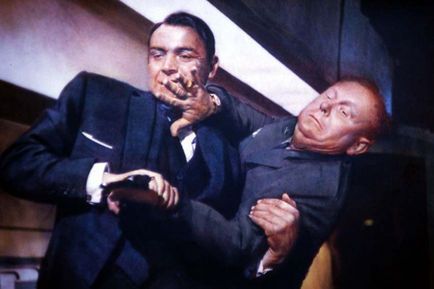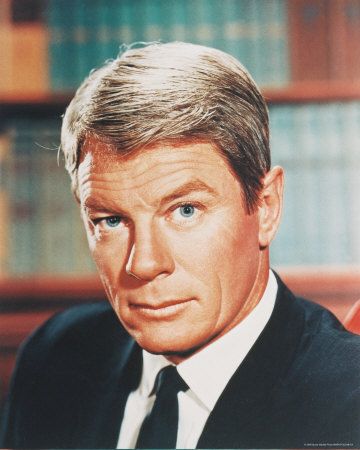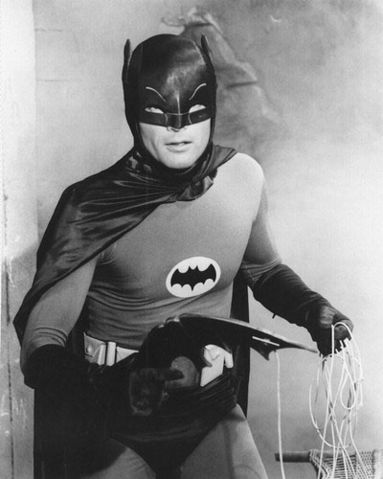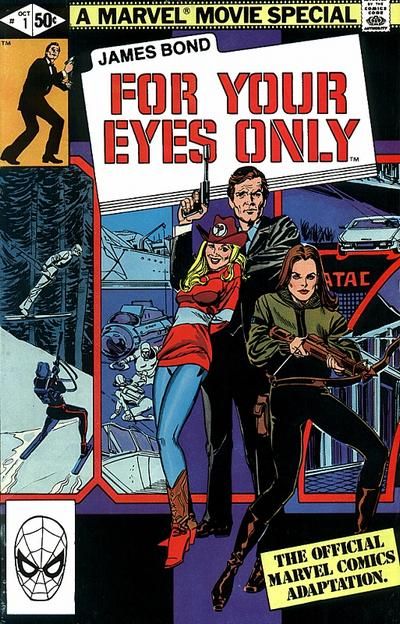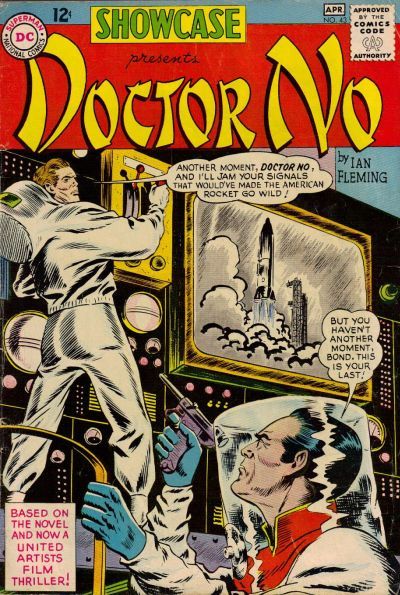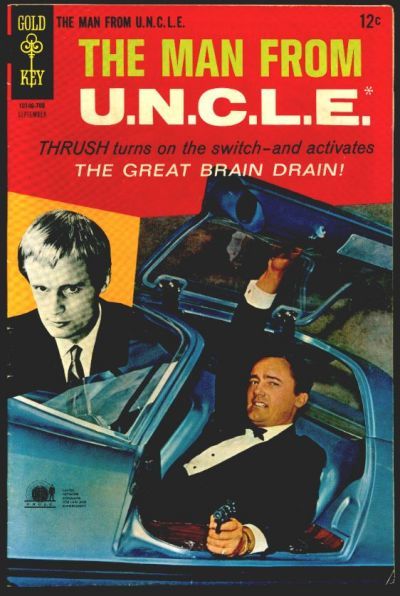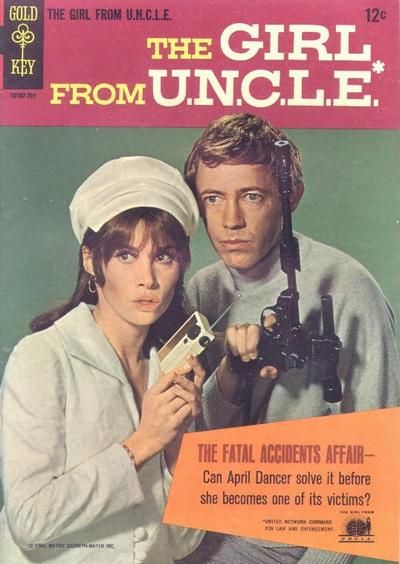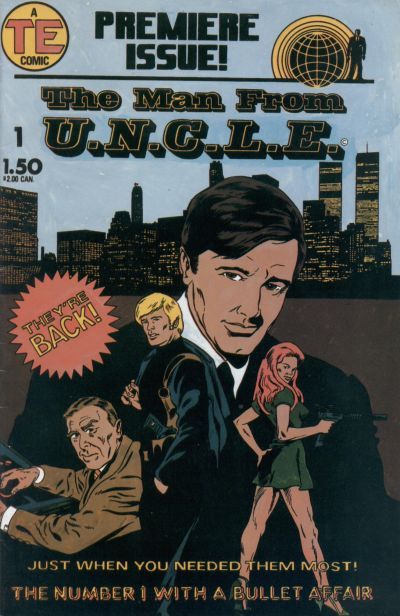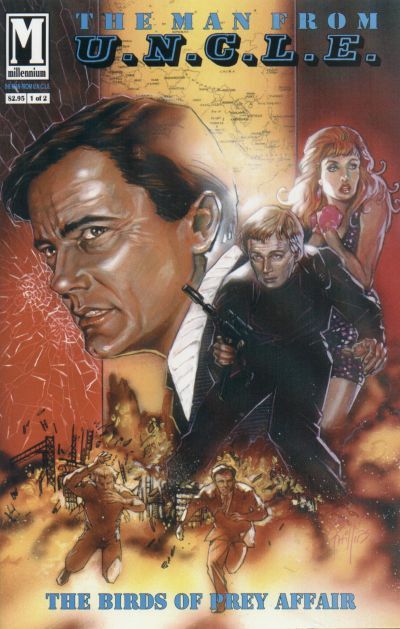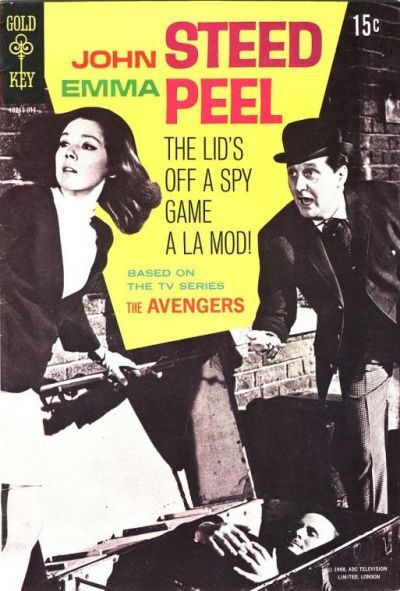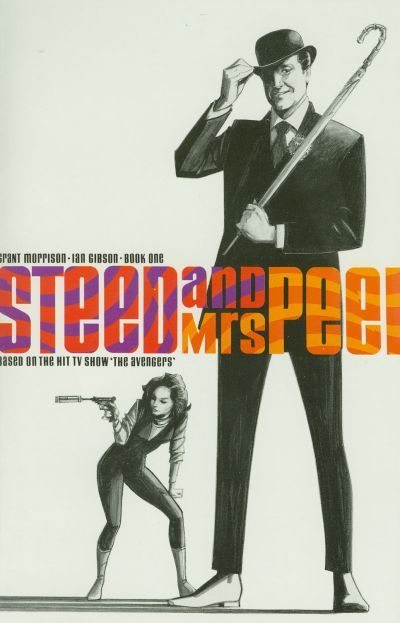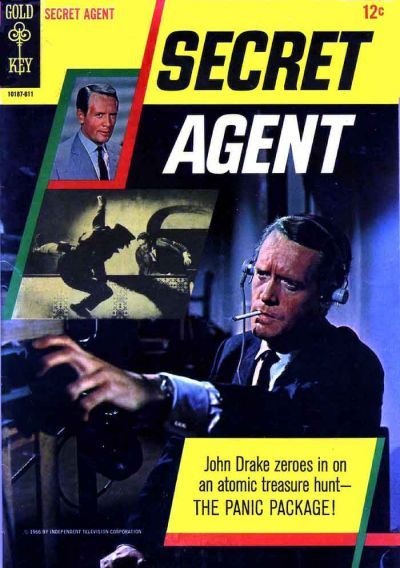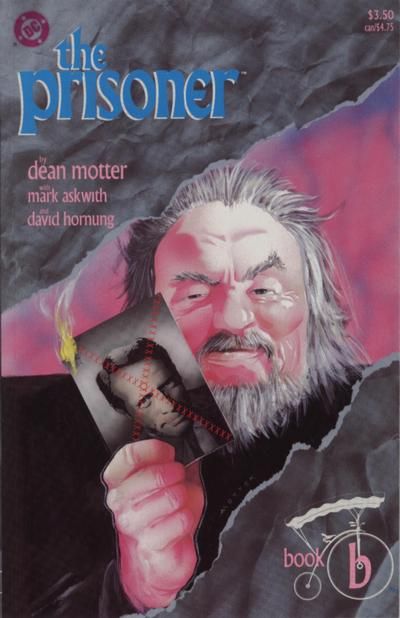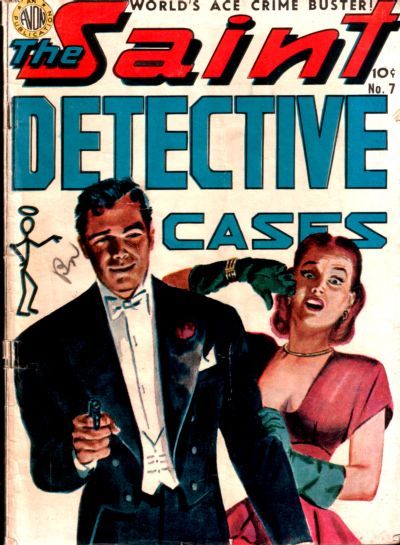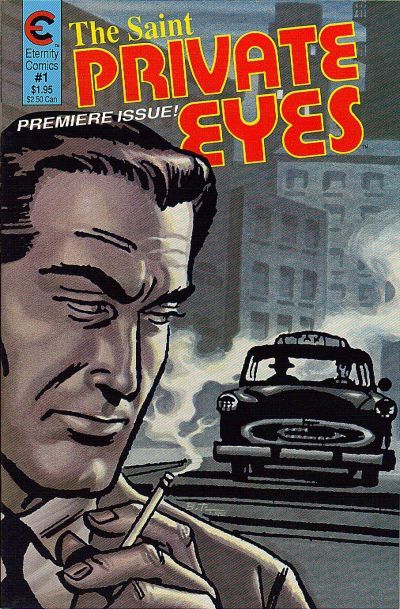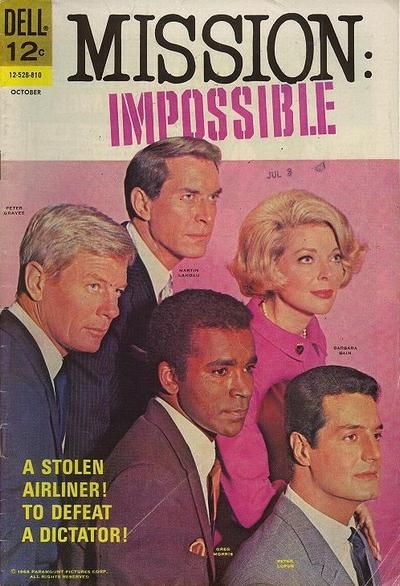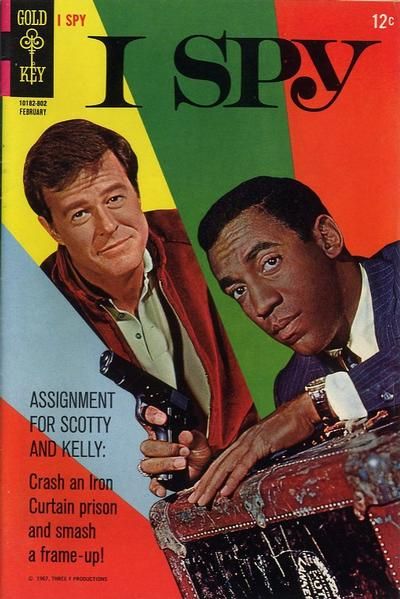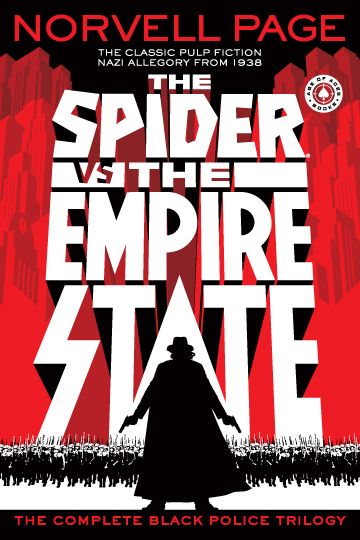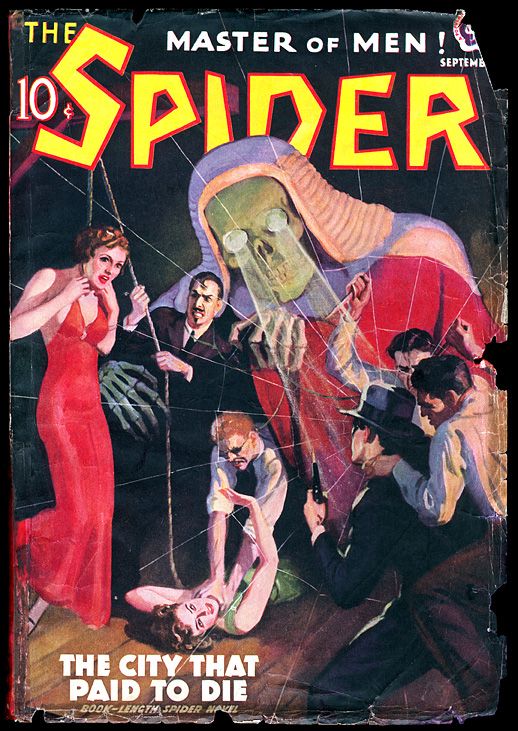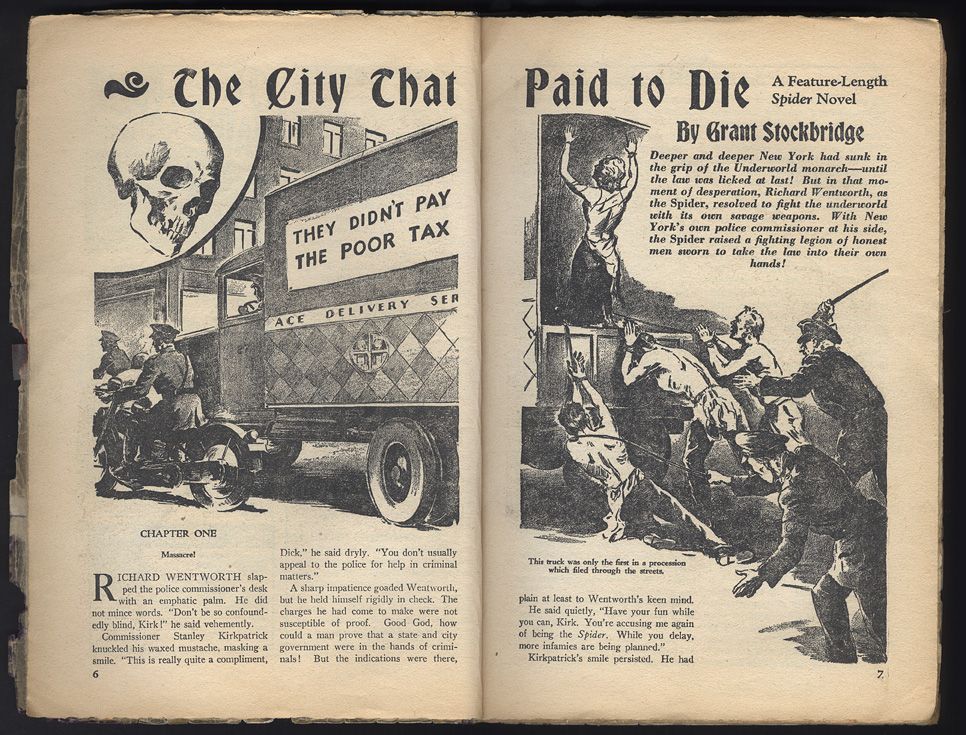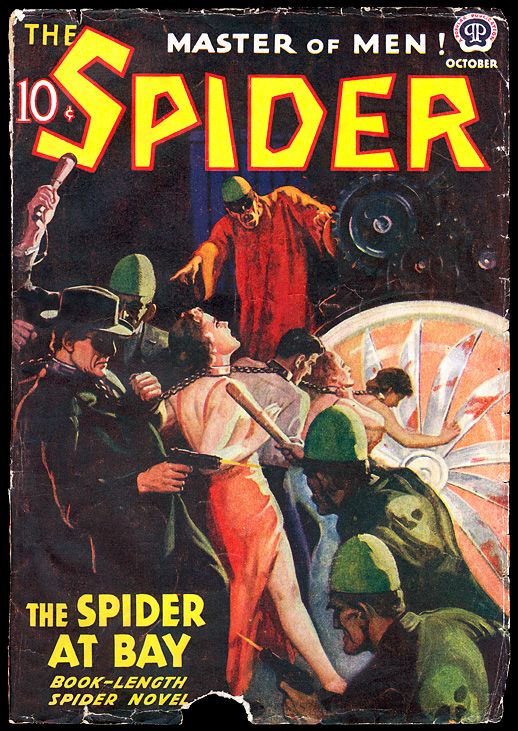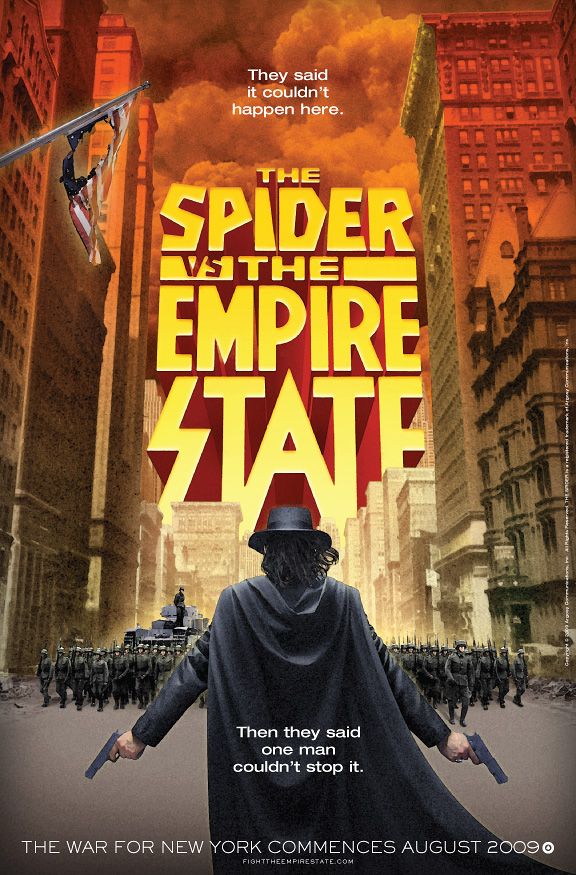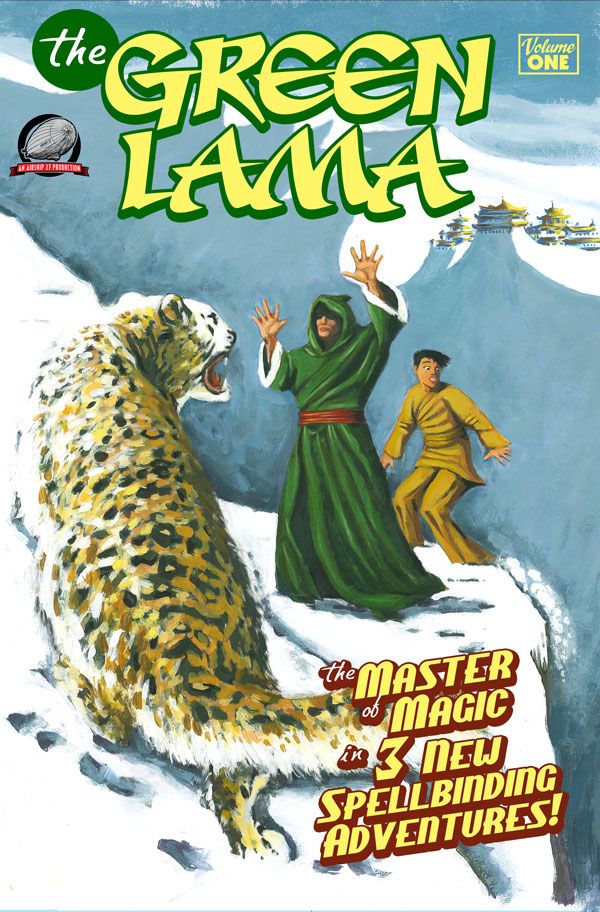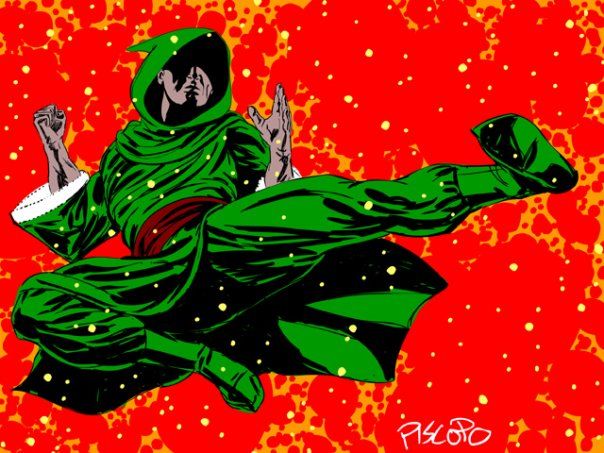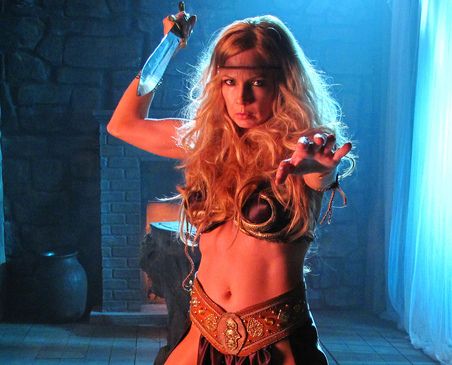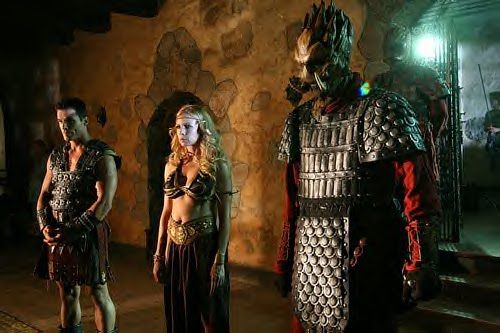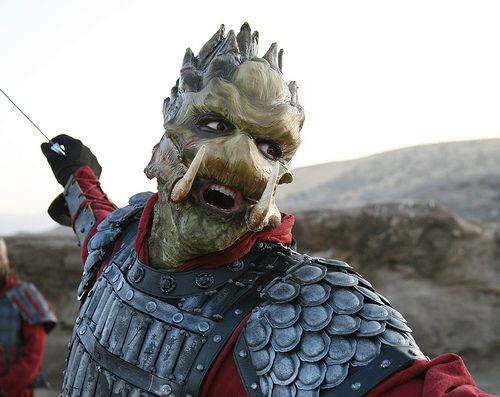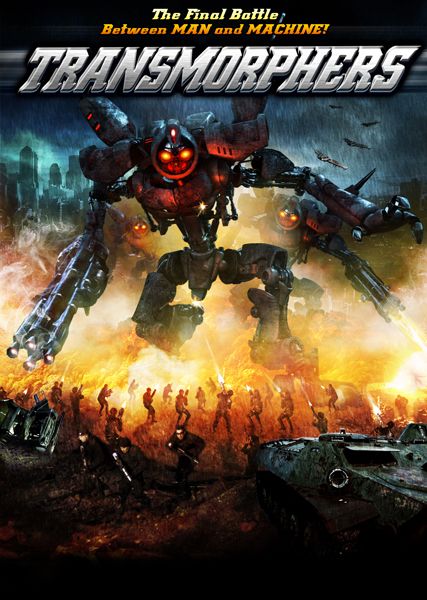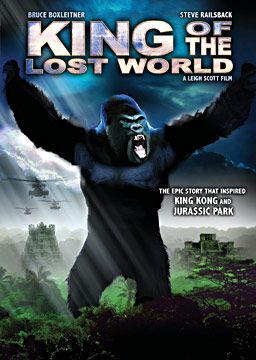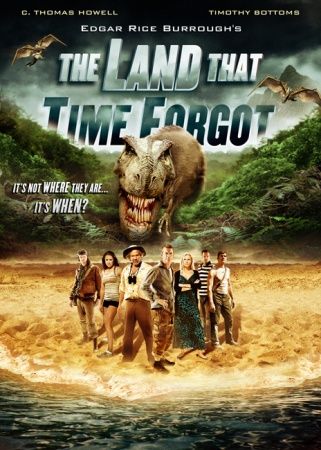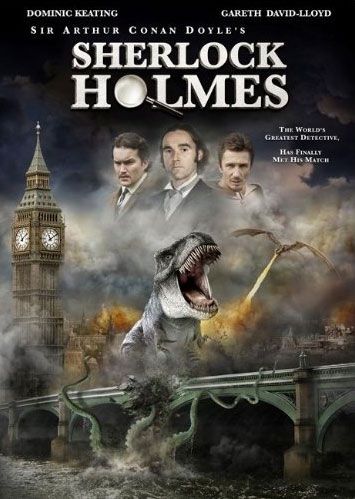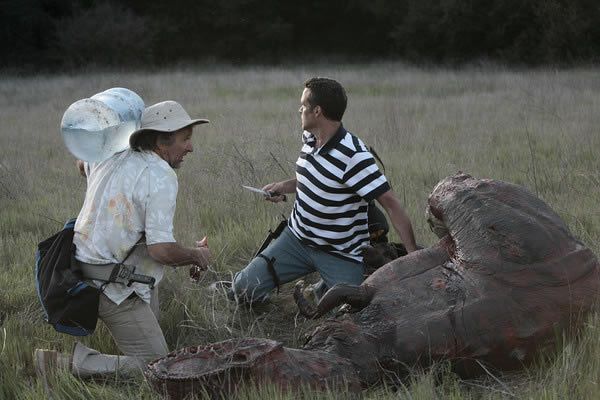Little things I wanted to mention here are piling up on me again, so let's see how many of them I can get off my desk today.
*
It was a little depressing to see two of my boyhood icons of cool pass away within the last couple of weeks.
I mean, I vaguely knew Peter Graves was getting up there, but losing Robert Culp a few days later took us all by surprise.
I couldn't help but feel a little twinge. Those two guys were a huge part of my childhood.
Growing up, I lived in a world bounded on four sides -- comics, books, TV, and movies. And in the first years I was learning to choose my own entertainment, from 1964 to 1968 or so, it was all about the superheroes (because of Adam West's Batman) and the super-spies (because of Goldfinger) and in my young brain I never really distinguished between the two. That was my initial definition of 'cool' and I don't know if at its core it's ever really changed since then.
I got to wondering if there were ever comics based on my old spy favorites. Obviously, I knew there was James Bond stuff, I even
did a whole column on those...
And of course UNCLE comics have been done as well.
Several times. In fact I think more comics were published here in the States about The Man From UNCLE then there were starring James Bond -- 22 from Gold Key, 11 from Entertainment, and two from Millennium, and that's not even counting The Girl From UNCLE, who had a five-issue Gold Key series of her own. (Once you leave the U.S., it's a different story... when it comes to the super-spies, 007 absolutely dominates the larger world comics scene. But Solo and Illya did respectably well for a while there in foreign markets too.)
And I knew The Avengers got a couple, as "Steed and Mrs. Peel." The later one was scripted by a young Grant Morrison, in fact.
Patrick McGoohan made it to comics in both of his super-spy incarnations.
Even the Saint had a comic, though this was actually done way before Roger Moore essayed the role on television. (The Eternity Comics one is just a reprint.)
So I went looking, and sure enough...
I Spy and Mission: Impossible both had comic-book tie-in series from Gold Key in the sixties. Of course, in their heyday Dell/Gold Key/Western got around to licensing EVERYTHING sooner or later. But still. That's kind of awesome.
Admittedly, it's even more depressing to realize how many of those actors are gone now; it's almost quicker to tally up the few that aren't dead yet. Nevertheless, it was fun finding all those covers and it seemed a pity not to share them, so there you go.
*
Speaking of characters showing up in areas you didn't expect them to, the columns about
pulp heroes crossing over to comics generated a surprising -- well, it surprised me, anyway -- amount of email and commentary. In particular, I wanted to mention a couple of books that crossed my path because of them.
The first was recommended to me by a number of folks, particularly my friend Perry Holley, but it's been mentioned to me many times since it came out last summer.
The Spider Vs. The Empire State is a really lovely collection that came out last August from from Age of Aces.
I finally caved and picked it up last week and it was indeed everything I'd been told... in fact, it changed my mind about the Spider pulps being just "good junk." This book is something more than that.
It collects the "Black Police Trilogy," a three-part story that ran through The Spider's magazine in the fall of 1938.
The story concerns a new kind of crime for Richard Wentworth; instead of him doing his usual masked-vigilante crimefighter thing, Wentworth finds himself leading a guerilla resistance movement against a fascist (but completely legal) takeover of New York State.
Sometimes Wentworth operates as the Spider, but by and large he acts openly as himself, often fighting side by side with the Spider's nemesis Police Commissioner Kirkpatrick (since the commissioner's refusal to cooperate with the new jackbooted regime has resulted in the corrupt governor declaring Kirkpatrick an outlaw right alongside Wentworth himself.)
I've made rude remarks about Norvell Page's fevered approach to writing the Spider pulps before, and I mostly still stand by them -- though I want to stress that when I say the Spider stories read like they were written during a 36-hour amphetamine jag, I mean that in a good way. It's that crazed narrative drive that gives them such tremendous power.
But this Black Police trilogy is different than the Spider's usual duel with some sneering evil pervert crimelord. This time, Norvell Page is writing an allegory about the various fascist things he saw happening out in the world, things like Huey Long and the rise of Nazi Germany, and he aims his relentless fever-dream imagination at those things like a big cannon. The book's still got all the things that made the Spider such a great pulp series -- the action and the heroics and the hell-for-leather pacing are all there in spades, the suspense never lets up for a second -- but this time, it feels important, it's really about something this time.
As a result, it's easily the most compelling Spider story I've ever read. For that matter, I'd go so far as to say that it may be the most compelling piece of pulp fiction I've ever read, and I've read a lot of it.
The allegory holds up amazingly well, particularly the parts about the ease with which corrupt profiteers slid right into city and state government positions and started using a media megaphone to terrify the populace and facilitate lining their own pockets. Although the promotional material and jacket copy is pushing the idea of Norvell Page using the Spider magazine to blare a warning about the looming Nazi menace in Europe, it actually reads as much more timeless than that. What struck me over and over as I was reading it was how modern it felt, I kept forgetting that it was supposed to be happening in 1938.
Finally I have to add that the design of the book just impressed the hell out of me. The publisher wisely decided not to go with the magazine-facsimile format that most of the folks in the pulp reprint business are using these days, and instead actually got a real designer, Chris Kalb. He's put together a very modern-looking trade paperback that nevertheless manages to incorporate all the original illustrations. It's a really classy package.
I could go on and on but the bottom line is that if you like pulp fiction or urban superheroics, this book is for you. Recommended unreservedly.
The other pulp-hero revival book arrived courtesy of one of its authors, Adam Garcia.
I'd mentioned this collection of new Green Lama stories as looking kind of cool, and Adam emailed to let me know that there were in fact a lot of books from Airship27 that I'd probably think were kind of cool. His initial idea was that they should send me review copies, but since it turned out that Airship27 doesn't actually do that, Adam made it a point to send me one of his personal writer's copies of the book instead. Which I thought was a really gracious thing to do; he even signed it to me, which got my wife all misty. ("That's so sweet!" was Julie's comment.)
Certainly it was much nicer to get a real book in the mail than the usual electronic PDF review copies we deal with here at CSBG (though I should add, those are fine with me, small-press guys. I've worked in small-press and believe me, I understand about constantly fighting with printing costs and not wanting to squander your real books on some internet blogger guy.)
Anyway, it seemed the least I could do was review it as soon as possible, though I have to admit it always makes me horribly nervous when authors are so nice about review copies. I'm always afraid I'm going to hate the book and then I'll have to find some graceful-but-honest way of writing it up.
Okay? Preceding was preamble. I just wanted it clear that I really appreciated Mr. Garcia's gesture before I started beating up on his book.
That said, the book itself is a mixed bag. It's got three new Green Lama adventures written by Kevin Noel Olson, Adam Garcia and Peter Miller. The illustrations are by Jay Piscopo and the cover is by Mike Fyles.
Like most anthologies, I found this to be an uneven effort. The first one, Kevin Olson's "Shiva Enangered," is a story of the Lama in Tibet, returning to the monastery that taught him in order to save the village from Nazi raiders. Like the Nazis in Raiders of the Lost Ark, the soldiers are hoping to gain mystic artifacts to aid in Hitler's conquest. It's entertaining and well-plotted, but the writing itself is occasionally a little jarring. I don't know if Mr. Olson is intentionally attempting to evoke the awkward pulp phrasing of yesteryear, but the truth is that the prose could have been helped along a great deal with a little judicious copy-editing. There's a lot of places where he's using almost the right word -- for example, when you are having a sudden memory flashback in a stressful situation, I don't think you "reminisce," I think you would remember or flash back to. Using a word like "reminisce" takes the urgency out of the moment. That kind of thing. I don't mean to nitpick but this happens a lot in the story, to a point where it's actually distracting. So I'm afraid the first entry loses points for that. As it stands I can only give it a C-plus or so.
The second story is Adam Garcia's own "Horror In Clay." I am relieved to be able to tell you with a straight face that this is a much better story than the first one in both plot and execution, there's lots of great little character bits with the Lama and his supporting cast, and it's just a good time. This entry really anchors the book. Adam Garcia does a great job putting the Green Lama in a situation where he's dealing with a golem that's been sent to attack New York's Nazi Party, and he is clearly having a good time playing with both the Green Lama's established continuity and also other pulp mythology of the time. (Of course the Green Lama would have had to eventually run up against Cthulhu... it makes such perfect sense.) The great pleasure of doing pastiche stories like the ones in this collection is the advantage of hindsight, both in correcting flaws in the original piece and the ability to incorporate real historical things into it. Adam's done a great job with both. This one's an A.
The final story in the collection is W. Peter Miller's "the Studio Specter," which, again, I had mixed feelings about. It's a good story, a tale of the Lama set in old Hollywood and there's lots of fun in-jokes and set pieces about the film industry as it was back then. However, again I ran into a little bit of a block with the actual prose -- Miller writes the whole story in the present tense. The Green Lama grabs the wheel and slides over into the driver's seat. The truck hits a bump... you know, like that.
In fairness, it's done reasonably well, but I have always hated it when authors do that. It feels pretentious to me, it's the same kind of show-off style choice you see in a collegiate creative writing class. I especially hate it when I see this technique used in genre pieces (like this one.) My feeling is that if you're doing pulp fiction you should just own up and get on with it, and not try and raise it to a lit'ry level with prose tricks. I can't legitimately hold Mr. Miller responsible for the fact that his story ran headlong into a pet peeve of mine, but nevertheless that's what happened and there it is. So "The Studio Specter" didn't fare as well with me as it might have. My inclination is to afford it a barely-passing grade but honesty forces me to admit that it's better than that, I just hate the technique itself. So I'll pass on grading this one and just say Your Mileage May Vary.
In the final scoring, the book adds up to: one story that I liked well enough but seemed amateurish in execution, one that I genuinely enjoyed from start to finish, and one that irritated me. Definitely a mixed bag. (Although I'm glad that Adam's entry turned out to be the one I liked a lot.)
It's a nice package, certainly. I like the cover by Mike Fyles and I always appreciate it when these "new" pulp packages go the distance and get a real illustrator for the interiors as well.
Jay Piscopo contributes several black-and-white illos that have a great pulpy feel. I also enjoyed that each author got an afterword where he explained the process he used to arrive at the story. Really, the whole presentation strikes me as the kind of fan-driven labor of love that I remember from the old Byron Preiss Weird Heroes books.
But... even so, I regret to say that I think this book is only for the hardcore pulp-hero enthusiasts out there, and even those folks probably would have to really love the Green Lama to shell out for this. It goes for a price of $18.50, which is a pretty heavy investment for an anthology I'd rate as one-and-a-half good stories out of three, even if the one good one is a long novelette that makes up about half of the book. I think your money probably would be better spent on Adam Garcia's new Green Lama novel that's coming later this year... that sounds like a project that probably has all the good points of this book and none of its weaknesses.
I do wish Adam and his Airship27 colleagues the best of luck and I'm delighted that they're doing books like this at all. I just wish I liked this book better than I did.
*
Speaking of pulp classics (and other things perhaps not so classic) I was a bit startled to run across a movie called "Princess of Mars" when I was surfing cable TV a few nights ago. I've been following the journey of Edgar Rice Burroughs' John Carter of Mars from page to screen for a while now, and I can safely say that I never, never in a million years, would have considered Traci Lords for Dejah Thoris.
But there she was. I was boggled. I was sure the big-budget release with Taylor Kitsch was at least a year away. But nevertheless there they were: Dejah Thoris, John Carter, Tars Tarkas, Sola and the Thark Warriors, all right there on my TV screen.
I'm pretty plugged into the geek movie scene and I was completely befuddled. I'd never heard of this and it was obviously a recent effort. How the hell did the big-budget Disney-Pixar-whoever effort get morphed into this thing that was obviously shot in about three weeks out at Vasquez Rocks?
Answer? It hadn't. This was something else entirely, a straight-to-DVD effort from The Asylum.
The Asylum is a production company that specializes in knockoffs, low-budget movies that are designed to be kind of like the big-budget flavor of the month.
Not close enough for anyone to, like, sue or anything, but close enough that if you squint at the package in a dark room you might mistake the one for the other. This has been successful enough that it's got its own genre name now -- in the movie trade, they're called "mockbusters."
Once I figured this out I instantly felt much less horrified. I have a soft spot for this sort of grindhouse effort (truthfully I think that to be a comics fan, you have to have a soft spot for junk culture of all kinds) and it wasn't like I was making a huge investment.
The terrible truth is that Julie and I ended up purely enjoying the hell out of Princess of Mars. Yeah, it was shot on the cheap and yeah, it's pretty trashy and exploitative... but you could also see that someone involved with the production had actually read some Edgar Rice Burroughs and they were doing their best on their meager budget. The big change was updating John Carter from a Civil War veteran to a Marine serving in Afghanistan, but once the action moved to Mars it was all done very much in the spirit of Burroughs and stuck moderately close to the book, even keeping stuff like "my Princess" as a phrase of betrothal and the fight at the atmosphere plant. And Antonio Sabato was much more believable as John Carter, tough marine, than he would have been as John Carter, 19th-century gentleman soldier. You go to war with the army you have, as they say.
I won't go so far as to say this was good, exactly, but it was the kind of bad movie I like a lot. About on a level with The Sword and the Sorcerer. Let's put it this way -- I liked this movie better and thought it was a more honorable effort at a real Burroughs adaptation than Disney's animated Tarzan was.
In fact, I liked it well enough to pick up the DVD (it was only a couple of dollars, it wasn't like we spent real money) and even invested in a couple of other Asylum low-budget knockoffs.
Sherlock Holmes hasn't arrived yet, but we screened The Land That Time Forgot here with our five-year-old godson Phenix a couple of nights ago and enjoyed that one too. Phexix and I are both very fond of the original 1975 version with Doug McClure, and that is certainly the superior film... but for three dollars this was worth it just for the evening's fun we got out of it. I repeat that I don't recommend spending real money on any of these, but if you see it lying in the discount pile at your local video store for a couple of bucks, you could do worse. As Phenix puts it, "I liked when they blew up the dinosaur!"
That kind of sums up the Asylum in a nutshell: you have to put up with movies that have lower budgets and B-list actors, but they do generally come with more exploding dinosaurs. An exploding dinosaur is always entertaining.
*
That's about it for this time. Except I did want to congratulate
Greg Burgas on his five years with us. The other Greg and I have widely differing tastes -- it should be obvious by now that I'm much more forgiving than he is -- but I always enjoy what he has to say and I am lost in admiration at the sheer volume of work he gets out here. I have all I can manage just to do my one little weekly thing at CSBG, but Burgas manages that and two or three other irregular features besides: Comics You Should Own, Into The Back Issue Box, and the occasional straight editorial piece. What's more, they're all fun reads. My idea of a good reviewer is someone who's interesting to read even when you aren't particularly interested in the work under review. That's Greg. Congratulations to him and I hope he's here for a long time to come.
Me, I'll be back next week.

